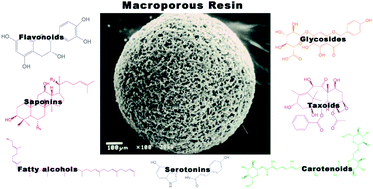Covering: up to the end of 2009
The development and characteristics of adsorptive (non-ionic) macroporous resins are described together with an overview and evaluation of recently reported applications of these macroporous resins in the purification of various pharmacologically-active natural products from plant sources. The versatility of adsorption using macroporous resins is demonstrated by the existence of numerous successful separation processes for many different categories of compounds, including polyphenols, glycosides and carotenoids. Adsorption by macroporous resins is considered to be superior to conventional liquid–liquid or solid–liquid extraction due to their inherent characteristics such as convenience, low operational cost, lower solvent consumption, and the absence of chemical residues in the product. In order to improve the resolution of the separations, efforts have been made either to combine the use of adsorptive macroporous resins with subsequent high performance column chromatography, e.g. preparative high performance liquid chromatography (HPLC) and high speed countercurrent chromatography (HSCCC), or to modify the surface chemistry and pore structure of resins.

You have access to this article
 Please wait while we load your content...
Something went wrong. Try again?
Please wait while we load your content...
Something went wrong. Try again?


 Please wait while we load your content...
Please wait while we load your content...